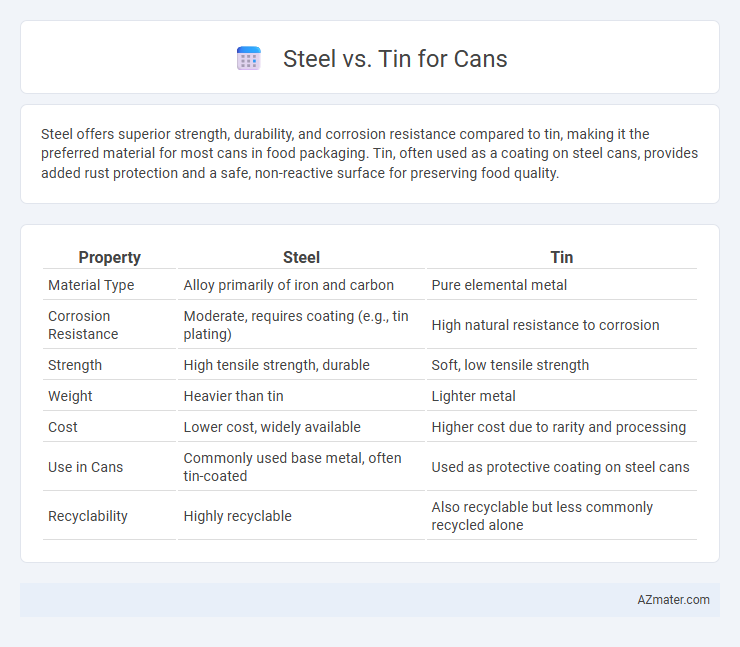Steel offers superior strength, durability, and corrosion resistance compared to tin, making it the preferred material for most cans in food packaging. Tin, often used as a coating on steel cans, provides added rust protection and a safe, non-reactive surface for preserving food quality.
Table of Comparison
| Property | Steel | Tin |
|---|---|---|
| Material Type | Alloy primarily of iron and carbon | Pure elemental metal |
| Corrosion Resistance | Moderate, requires coating (e.g., tin plating) | High natural resistance to corrosion |
| Strength | High tensile strength, durable | Soft, low tensile strength |
| Weight | Heavier than tin | Lighter metal |
| Cost | Lower cost, widely available | Higher cost due to rarity and processing |
| Use in Cans | Commonly used base metal, often tin-coated | Used as protective coating on steel cans |
| Recyclability | Highly recyclable | Also recyclable but less commonly recycled alone |
Introduction: Steel vs Tin in Can Manufacturing
Steel and tin are fundamental materials in can manufacturing, each offering unique properties that influence durability and corrosion resistance. Steel provides structural strength and magnetic qualities essential for heavy-duty applications, while tin coating on steel enhances rust protection and extends shelf life by preventing metal contamination. The choice between steel and tin-coated steel hinges on balancing cost, protection level, and intended use in food or beverage packaging industries.
Historical Overview of Steel and Tin Cans
The development of tin cans began in the early 19th century, revolutionizing food preservation by providing a lightweight, corrosion-resistant container made from thin sheets of tinplate. Steel cans emerged later as a sturdier alternative, utilizing coated steel to enhance durability and cost-effectiveness while maintaining resistance to corrosion through tin or chromium plating. This historical transition from tin to steel cans marked significant advancements in packaging technology, improving scalability and product safety in the food industry.
Material Composition: Steel Can vs Tin Can
Steel cans are primarily composed of iron with small amounts of carbon and often feature a thin layer of tin plating to prevent rust and corrosion. Tin cans, historically made from steel coated with tin, refer specifically to this tin-plated steel rather than pure tin metal, which is too soft for practical use as a container. The steel core provides structural strength, while the tin coating ensures food safety and extends shelf life by inhibiting metal oxidation.
Strength and Durability Comparison
Steel cans offer superior strength and durability compared to tin cans, making them more resistant to dents and deformation during transportation and storage. The high tensile strength of steel provides enhanced protection against environmental factors like moisture and impact, extending the shelf life of the contents. Tin, often used as a coating rather than a standalone material, lacks the structural integrity of steel and is more prone to corrosion and damage.
Corrosion Resistance and Longevity
Steel cans offer superior strength and longevity due to their thicker material composition, but they require protective coatings like tin or chromium to resist corrosion effectively. Tin, used as a coating on steel cans, provides excellent corrosion resistance by forming a non-reactive layer that prevents rust and metal degradation, extending the can's lifespan significantly. While tin-coated steel cans excel in durability and resistance to acidic or moist contents, uncoated steel is more prone to rust and shorter service life without proper treatment.
Weight and Transport Considerations
Steel cans typically weigh more than tin cans, impacting transportation costs and fuel consumption due to the increased load. The higher density of steel can lead to greater carbon emissions during transit, making weight a critical factor for logistics optimization. Choosing tin, which is lighter, can reduce shipping expenses and improve handling efficiency while maintaining adequate durability for packaging.
Cost Analysis: Steel vs Tin Cans
Steel cans generally offer a lower production cost compared to tin cans due to the abundance and affordability of raw materials, making steel a cost-effective option for high-volume packaging. Tin cans, though more expensive because of the higher cost of tin plating and enhanced corrosion resistance, provide superior protection for certain contents, justifying their price in specific applications. When analyzing the cost-efficiency of steel versus tin cans, factors such as material price volatility, manufacturing processes, and corrosion prevention methods significantly impact the total expenditure.
Environmental Impact and Sustainability
Steel cans have a higher recycling rate worldwide, reducing landfill waste and lowering environmental impact compared to tin cans. Steel is made from abundant iron ore and is infinitely recyclable without loss of quality, promoting sustainability through resource efficiency. Tin, often used as a coating, involves more energy-intensive extraction and processing, increasing its carbon footprint relative to steel-based cans.
Common Applications and Industry Preferences
Steel cans dominate the food packaging industry due to their durability, magnetic properties for quality control, and excellent protection against contamination. Tin cans, often used for specialty food products and smaller-scale packaging, are valued for their corrosion resistance and ease of sealing. The beverage sector primarily prefers steel for larger containers, while tin finds niche applications in decorative and premium packaging.
Conclusion: Choosing Between Steel and Tin for Cans
Steel offers superior strength, durability, and magnetic properties, making it ideal for heavy-duty or vacuum-sealed cans, while tin provides excellent corrosion resistance and a non-toxic, food-safe coating preferred for delicate contents. The choice depends on application requirements: steel suits industrial, long-term storage or recycling efficiency, whereas tin excels in preserving flavor and preventing contamination in food packaging. Cost considerations and sustainability goals also influence the decision, with steel's recyclability balancing tin's food-safety benefits.

Infographic: Steel vs Tin for Can
 azmater.com
azmater.com